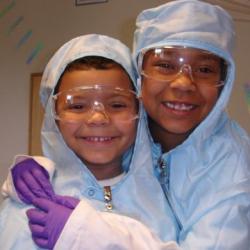Source Institutions
Source Institutions
Add to list Go to activity
Activity link broken? See if it's at the internet archive

In this activity, learners discover why some nanoscale science and technology is done in the controlled environment of a clean room, what clean rooms are like, and how scientists help keep the clean room clean. During the program, learners sniff scents to analyze particles too small to see, try on the head-to-toe suits that scientists wear in clean rooms, and manipulate pretend silicon wafers with tweezers.
- Under 5 minutes
- 10 to 30 minutes
- Over $20 per group of students
- Ages 4 - adult
- Activity, Demonstration, Lesson/Lesson Plan
- English
Quick Guide
Materials List (per group of students)
- Shoe covers, universal size (LSS #966P)
- Hooded coverall with boots, size small (VWR #10844-420)
- Safety glasses for children (Carolina #646713)
- Safety glasses for adults
- Nitrile gloves in two or more colors
- Squeeze bottles and flip tops (United States Plastic)
- Edible food extracts, e.g. vanilla extract, anise seed oil, etc. (grocery stores)
- Molecular models of the primary esters (fragrant molecules) in the extracts (optional)
- Petri dishes (Carolina #741248) (Real wafer cases are very expensive, but you can use them if you have them)
- Laminated images of silicon wafers
- Nitrile gloves
- Plastic tweezers
- Can of compressed gas for dusting electronics (electronics or office supply stores)
- Sticky mat (VWR #89041-740)
- Clean room paper (VWR #47742-558)
- Clean room pens
- Clean room wipes (optional—LSS #56918)
- Clean room swabs (optional—LSS #40397)
- Clean room lotion (optional—VWR #56614-108)
- Clean room lip balm (optional—VWR #14221-444)
- Wafer tweezers (optional—VWR #63042-106)
- Images to use during the program (PowerPoint, or printed and laminated)
Subjects
-
Engineering and Technology
-
Engineering
- Computer Engineering
- Electrical Engineering
- Manufacturing Engineering
- Nanotechnology
-
Technology
- Medical Technology
- Agriculture and Biotechnology
- Information and Communication
-
Engineering
-
Life Sciences
-
Human Senses and Perception
- Smell
-
Human Senses and Perception
-
The Nature of Technology
- Technology and Society
Informal Categories
- Computers
Audience
To use this activity, learners need to:
- see
- smell
- touch
Learning styles supported:
- Involves hands-on or lab activities
Other
Components that are part of this resource:
- Tiny Particles, Big Trouble Lesson Plan
- Tiny Particles Lab Image 1
- Tiny Particles Lab Image 2
- Tiny Particles Dime/Chip Image
- Tiny Particles Dust on Chip Image
- Tiny Particles Lab Image 3
- Tiny Particles Lab Image 4
- Tiny Particles Lab Photo
- Tiny Particles Presentation
- Tiny Particles Wafer Image
- Tiny Particles Training Video
This resource is part of:
Access Rights:
- Free access
By:
Rights:
Funding Sources:
- National Science Foundation, 0532536
- National Science Foundation, 0940143
